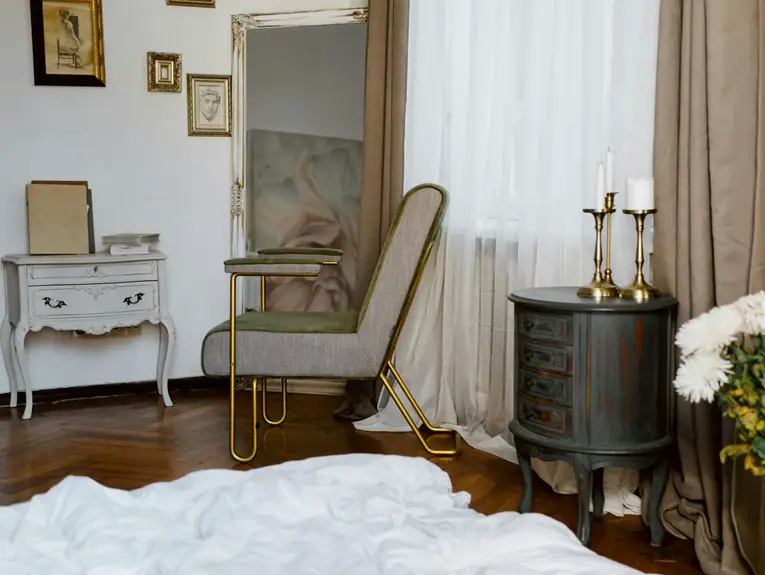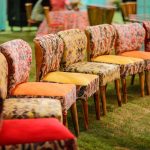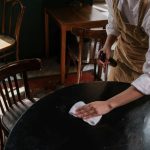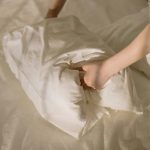If you find mildew on your fabric lawn furniture, start by brushing off loose dirt and gathering supplies like mild detergent, white vinegar, a soft brush, and clean water. Mix a cleaning solution, apply it to mildew spots, then gently scrub in circular motions. Rinse thoroughly and let the fabric air dry completely in sunlight to prevent mildew from returning. With some simple care and prevention, your outdoor furniture can stay fresh and inviting for seasons to come.
Table of Contents
Key Takeaways
- Identify mildew by spotting fuzzy patches and musty smells on fabric, especially in shaded or damp areas.
- Prepare a cleaning solution using mild detergent or white vinegar for natural mildew removal.
- Gently scrub mildew-affected fabric with a soft brush or sponge using circular motions.
- Rinse thoroughly with clean water and air dry furniture completely in sunlight to prevent moisture.
- Prevent future mildew by keeping fabric dry, using breathable covers, and storing cushions indoors during wet seasons.
Identifying Mildew on Fabric Lawn Furniture
How can you tell if your fabric lawn furniture has mildew? Look closely for small, fuzzy patches that often appear gray, white, or greenish. These spots usually form in damp, shaded areas where moisture lingers.
You might notice a musty or earthy smell, which is a clear sign mildew has started to grow. If the fabric feels damp or sticky even after drying, mildew could be the culprit.
Don’t confuse mildew with dirt or stains; mildew often spreads quickly and can damage the fabric fibers. Check seams, folds, and under cushions—mildew loves hidden, moist spots.
Mildew spreads fast and harms fabric—inspect seams, folds, and under cushions where moisture hides.
Acting quickly once you spot these signs helps prevent permanent damage and keeps your furniture looking fresh and inviting all season long.
Essential Cleaning Supplies for Mildew Removal
You’ll need a few key supplies to effectively tackle mildew on your fabric lawn furniture.
Start with a soft-bristle brush or sponge to gently scrub away mildew without damaging the fabric. Grab a bucket for mixing your cleaning solution, which typically includes white vinegar or a mild detergent—both are effective and safe for outdoor fabrics.
Have clean water ready for rinsing afterward. Don’t forget rubber gloves to protect your skin from irritants in the cleaning agents. A spray bottle can also come in handy for applying solutions evenly.
Finally, keep a few clean towels or microfiber cloths nearby to blot excess moisture after cleaning. With these supplies on hand, you’ll be well-prepared to remove mildew and restore your furniture’s appearance.
Preparing Your Furniture for Cleaning
Before tackling mildew removal, start by setting up your workspace and preparing the furniture properly.
Choose a well-ventilated outdoor area or a spot with plenty of sunlight to prevent spores from lingering indoors. Remove any loose cushions or fabric covers and set them aside for separate cleaning.
Next, brush off loose dirt and debris from the fabric using a soft brush or vacuum with an upholstery attachment. Check for any tears or damage, so you can avoid worsening them during cleaning.
Gently brush or vacuum fabric to remove dirt, inspecting for tears to prevent further damage during cleaning.
If possible, detach fabric parts from the furniture frame to allow thorough cleaning and drying.
Finally, protect surrounding plants or surfaces by laying down a tarp or old sheets.
These steps guarantee your furniture is ready for an effective mildew cleaning process.
Step-by-Step Mildew Cleaning Process
First, you’ll want to spot the mildew by checking for those telltale dark spots and musty smells.
Next, mix up a cleaning solution that’s tough on mildew but safe for your fabric.
Finally, apply the solution carefully, scrub gently, and rinse thoroughly to restore your furniture.
Identify Mildew Signs
Mildew often appears as small, discolored spots or patches on your fabric lawn furniture, usually in damp or shaded areas. To effectively remove it, you first need to identify the signs clearly. Look for fuzzy or powdery textures and a musty odor. These indicators show mildew is present and needs attention.
| Sign | What to Look For |
|---|---|
| Discoloration | White, gray, or greenish spots |
| Texture | Fuzzy or powdery appearance |
| Location | Damp, shaded, or rarely cleaned areas |
| Odor | Musty, moldy smell |
Recognizing these signs early helps you act quickly and prevent mildew from spreading.
Prepare Cleaning Solution
To tackle mildew effectively, you’ll need to prepare a reliable cleaning solution using common household ingredients. This step is essential because the right mix not only removes mildew but also prevents damage to your fabric furniture.
Here’s how you can prepare it:
- Gather 1 cup of white vinegar, known for its natural antifungal properties.
- Add 1 cup of warm water to dilute the vinegar without losing its strength.
- Mix in 1 tablespoon of baking soda to boost cleaning power and deodorize.
- Optionally, include a few drops of mild dish soap to break down stubborn mildew stains.
Combine these ingredients gently in a spray bottle or bucket. This solution balances strength and safety, making your cleaning both effective and gentle on fabric.
Apply and Rinse
Spray the cleaning solution evenly over the fabric, making sure to cover all mildew-affected areas thoroughly.
Let it sit for about 10 to 15 minutes to break down the mildew, but don’t let it dry completely.
After the solution has had time to work, grab a soft brush or sponge and gently scrub the fabric in circular motions. This helps lift the mildew without damaging the material.
Once you’ve scrubbed all affected spots, rinse the fabric thoroughly with a hose or a bucket of clean water. Make sure to remove all soap and residue, as leftover solution can attract dirt or cause discoloration.
Finally, allow the furniture to air dry completely in the sun, which helps kill any remaining mildew spores naturally.
Alternative Natural Remedies for Mildew
Although commercial cleaners are effective, you might prefer natural remedies that are safer for both your health and the environment.
Natural remedies offer a safer, eco-friendly alternative to commercial cleaners for tackling mildew on fabric lawn furniture.
These alternatives can tackle mildew on your fabric lawn furniture without harsh chemicals. Here are four natural options you can try:
- White Vinegar: Spray undiluted vinegar on mildew spots, let it sit for an hour, then scrub gently.
- Baking Soda Paste: Mix baking soda with water to form a paste, apply it to stains, and scrub after 15 minutes.
- Lemon Juice: Apply lemon juice directly, which naturally kills mildew and leaves a fresh scent.
- Tea Tree Oil Solution: Combine a teaspoon of tea tree oil with a cup of water, spray, and wipe away mildew.
These remedies are gentle yet effective, helping you restore your furniture safely.
Preventing Future Mildew Growth
Since mildew thrives in damp, shaded areas, you’ll want to keep your fabric lawn furniture dry and well-ventilated to prevent future growth.
After cleaning, always let your furniture air out completely before covering or storing it. Avoid placing your furniture directly on wet grass or soil, and if possible, position it where sunlight can reach it for some part of the day.
Using breathable furniture covers helps reduce moisture buildup while allowing airflow. Regularly inspect your furniture for early signs of mildew so you can act quickly.
Also, store cushions and removable fabric parts indoors during rainy seasons or when not in use for extended periods.
Taking these steps helps you keep mildew at bay and extends the life of your lawn furniture’s fabric.
Tips for Maintaining Fabric Lawn Furniture Outdoors
To keep your fabric lawn furniture looking its best, you’ll need to perform regular maintenance that goes beyond just cleaning mildew.
Taking care of your outdoor pieces guarantees they stay comfortable and inviting all season long. Here are some essential tips to maintain your fabric lawn furniture:
- Rotate cushions regularly to prevent uneven wear and fading.
- Store cushions in a dry, ventilated area when not in use to avoid moisture buildup.
- Use fabric protectors designed for outdoor use to repel stains and mildew.
- Clean spills immediately and schedule deep cleanings seasonally to keep fabrics fresh.
Frequently Asked Questions
Can Mildew on Fabric Lawn Furniture Cause Health Issues?
Yes, mildew on fabric lawn furniture can cause health issues. You might experience allergies, respiratory problems, or skin irritation when exposed. It’s important you clean and remove mildew promptly to protect your health and comfort.
Is It Safe to Use Bleach on All Types of Fabric?
Bleach sounds like a quick fix, but it’s not safe for all fabrics. While it kills mildew effectively, it can damage colors or weaken fibers. You’ll want to test or choose gentler alternatives instead.
How Long Does Mildew Take to Develop on Outdoor Furniture?
Mildew can start developing on outdoor furniture within 24 to 48 hours if it’s damp and in a humid environment. You’ll want to clean it promptly to prevent stubborn stains and damage from setting in.
Can Mildew Return After Professional Cleaning?
Imagine you just had professionals clean your cushions, but after a rainy week, mildew reappears. Yes, mildew can return if moisture lingers or conditions stay damp, so you need to keep fabrics dry and well-ventilated.
Are There Specific Fabrics More Resistant to Mildew?
You’ll find that synthetic fabrics like solution-dyed acrylic and polyester resist mildew better because they repel moisture and dry quickly. Natural fibers tend to hold moisture, making mildew growth more likely on those materials.
- Tetron Fabric for Marine Applications: Durability and Use Cases - June 18, 2025
- Tetron Fabric for Outdoor Furniture: Weather Resistance and Care - June 18, 2025
- Tetron Fabric for Wall Coverings: Style and Application Tips - June 18, 2025







